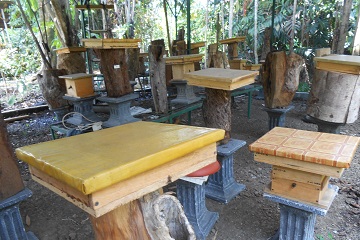A Group of IPB Experts Analysed Pollen collection Activity of “Teuweul Omas” the Stingless Bees

Bees are flying insects closely related to wasps and ants, known for their role in pollination and, in the case of the best-known bee species, the European honey bee, for producing honey and beeswax. Some species including honey bees, bumble bees, and stingless bees live socially in colonies. Stingless bees are characterized by complex communication, permanent colonies, and has division of caste (queen, males, and workers). Bees range in size from tiny stingless bee species whose workers are less than 2 millimetres (0.08 in) long, to Megachile pluto, the largest species of leafcutter bee, whose females can attain a length of 39 millimetres (1.54 in). Human beekeeping or apiculture has been practised for millennia, since at least the times of Ancient Egypt and Ancient Greece. Apart from honey and pollination, honey bees produce beeswax, royal jelly and propolis. However, many do not know the various types of honey-producing bees. A honey bee (or honeybee) is any member of the genus Apis, primarily distinguished by the production and storage of honey and the construction of perennial, colonial nests from wax.
Tetragonula is a genus of stingless bees. In 1 961, Brazilian bee expert, Professor J.S. Moure, first proposed the genus name Tetragonula to improve the classification system by dividing the large genus Trigona stingless bees 9 smaller groups. They are also known for their small body size, reduced wing venation, and highly developed social structure comparable to honey bees. The main characteristics of high-level social insects include clear division of tasks in each caste and communication between members of the colony about the location of the feed. The three types of honey bees in a hive are: queens (egg-producers), workers (non-reproducing females), and drones (males whose main duty is to find and mate with a queen).
The morphological characteristics of worker “teuweul omas” are 4.445±0.072 mm body length, 1.911±0.019 mm head width, mesoscutum with distinct hair bands (well banded) separated by glabrous interspaces area, with plumose frontal hairs, and black metasoma, legs, and hairs on the frontal. Based on morphological characteristics of the body, "teuweul omas" was grouped in the genus Trigona, subgenus Tetragonula, and iridipennis group.
Information about Tetragonula feed plants is indispensable. The availability of feed affects flight activity, since most of the activity is looking for feed that has an impact on productivity. Such issue was the basic reason why the research team from the Department of Biology, Faculty of Mathematics and Natural Sciences (FMIPA) Bogor Agricultural University (IPB), Selly Sahara Hasibuan, Tri Atmowidi and Taruni Sri who conducted research program related to nest in and out activities in "teuweul omas" (Tetragonula sp .).
The research was carried out in January-July 2016. Sampling and observation for the activities of "teuweul omas" was carried out in the lahan apiari owned by Gregori Garnadi Hambali, Baranangsiang Indah, Bogor City.
Observation of nest in and out activity were carried out on two colonies of "teuweul omas" for 30 days starting at 06.00-18.00 WIB. The nest in and out activity had been recorded with a camcorder for one minute with an hour interval.
The data of nest in and out activities were obtained by counting the number of individuals "teuweul omas" entering the nest carrying pollen, entering the nest carrying resin (sap), leaving the nest without carrying garbage, and out of the nest carrying the garbage. Individuals "teuweul omas" who carry no pollen or resin are assumed to carry water or nectar. Prior to observation of nest in and out activities, environmental factors (temperature, humidity and light intensity) were measured.
The research revealed that the most bee activity of nest entry for binging in pollen for "teuweul omas" in the morning is 06.00-07.00 WIB, as many as 8 individuals / minute; At 12:00 to 13:00 pm as many as 10 individuals / minute entry and 9 individuals / minutes out of the hive; and at 17:00 to 18:00 pm as many as 2 individuals / minute. This nest in and out activity is related to temperature and light intensity and is not significantly affected by moisture.
A very significant linkage exists between environmental factors (temperature, humidity and light intensity). Once back at the hive, the workers stuff the pollen into an awaiting cell. with the activity of entering the nest carrying water or nectar and out of the nest carrying garbage. Pollen is an essential part of the honey bee diet, providing a wide range of nutrients including protein, carbohydrates, lipids, vitamins, and minerals. Polen as a source of feed "teuweul omas" have been identified, namely C. pulcherrima, C. Portulacaceae, C. papaya, Pinaceae, Solanaceae and Leguminosae. The average pollen load on "teuweul omas" is 19,475,7 pollen grains. Most bees collect just pollen or just nectar on any trip, but a few carry both at the same time. The pollen is stuffed into hairy receptacles on their hind legs called corbiculae. A single bee can carry about half her own body weight in pollen. This means that "Teuweul omas" becomes one of the potential pollinating insects in its ability to carry the pollen. (Wied)



